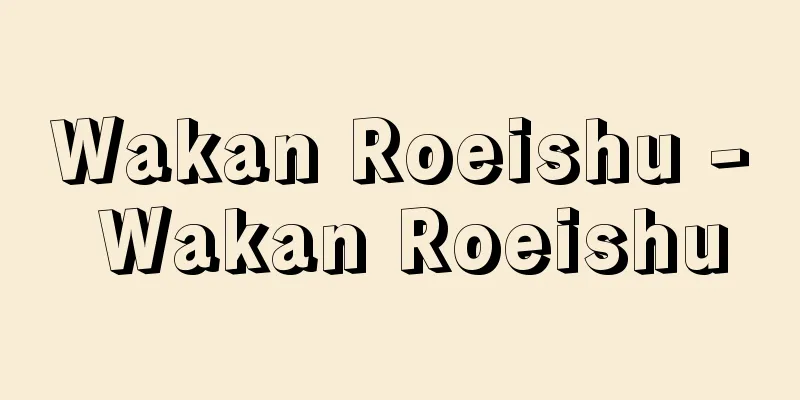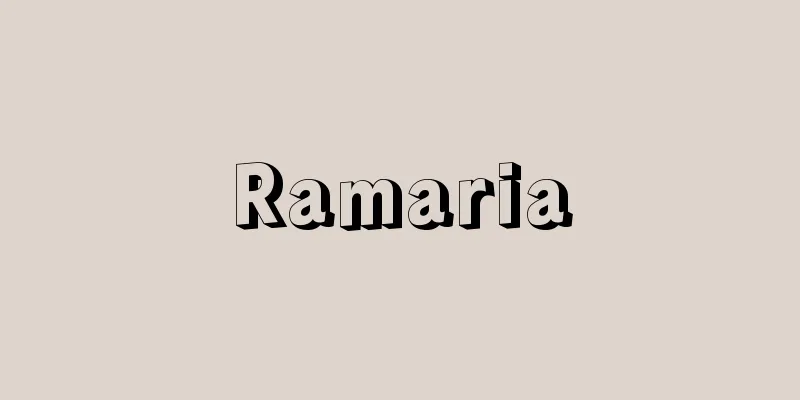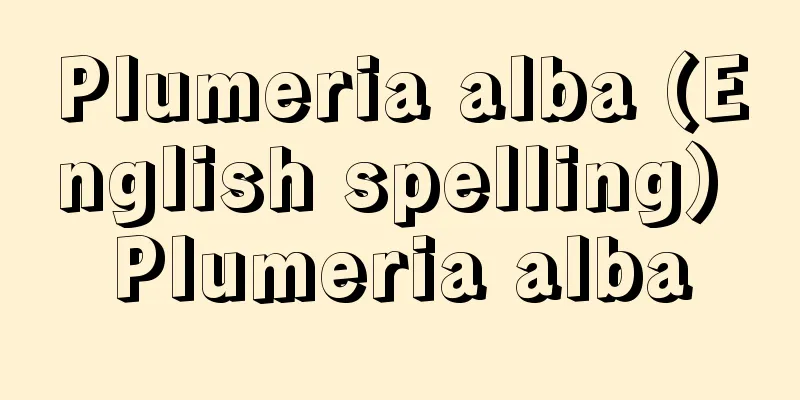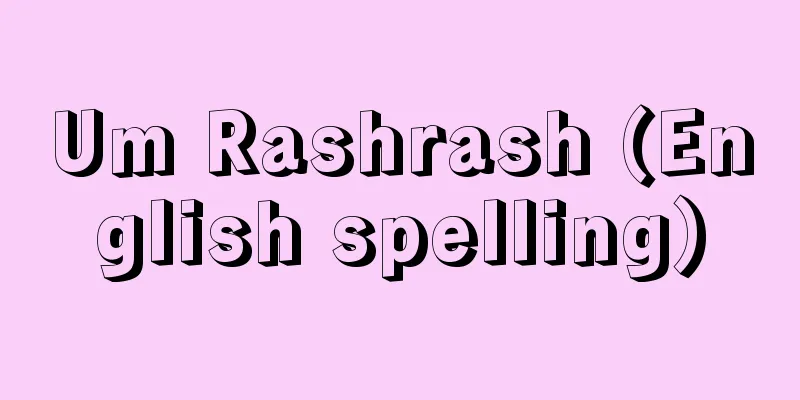Wakan Roeishu - Wakan Roeishu

|
A collection of folk songs from the mid-Heian period. Two volumes. Also known as Wakan Roeisho, Wakansho, and Shijo Dainagon Roeishu. Compiled by Fujiwara no Kinto. "Wakan" refers to waka and Chinese poetry, and the two volumes contain 588 excellent phrases in Chinese poetry suitable for reciting, and 216 waka poems, for a total of 804 poems. The first volume is a seasonal arrangement of the four seasons starting with the beginning of spring, while the second volume is an encyclopedia-style classification of miscellaneous topics related to celestial phenomena, plants and animals, and human affairs, divided into a total of 114 items (125 if additional items are included). As a rule, each item is arranged in the order of long phrases and verses by Chinese people, followed by long phrases, verses, and waka poems by Japanese people. Most of the poems consist of two lines of seven characters each, and often consist of one of the two couplets in a seven-character regulated verse (the most elegant couplets are the third and fourth, or the fifth and sixth lines). While there are many quotations from "Senzai Jia Ku" and "Kokin Waka Rokujo," the Chinese authors are almost exclusively poets of the Tang dynasty, with many from the middle and late Tang period. Among them, Bai Juyi far surpasses Yuan Zhen and others, accounting for nearly 70% of the Chinese verses. Among Japanese poets, Sugawara no Michizane (first in number of verses) and Sugawara no Fumitoki (first in total number of verses and verse excerpts) are followed by poets from the Tenryaku period (947-957), such as Oe no Asatsuna, Minamoto no Shitago, and Ki no Haseo. Among waka poets, Ki no Tsurayuki and Oshikouchin no Mitsune are highly respected, and both reflect the aesthetic sense of the Ichijo era. It was considered a basic text for the academic education of aristocrats and samurai, and had an enormous influence on later literature, both Japanese and Chinese, giving rise to subsequent similar works such as the Shinsen Roeishu. [Hideo Watanabe] "Shincho Japanese Classics Collection: Wakan Roeishu (1983, Shinchosha), edited by Shosuke Ozone and Hideaki Horiuchi" ▽ "Kawaguchi Hisao, "A Study of the History of Japanese Chinese Literature in the Heian Period," Vol. 1 (1975, 1982, Meiji Shoin)" Source: Shogakukan Encyclopedia Nipponica About Encyclopedia Nipponica Information | Legend |
|
平安時代中期の歌謡。二巻。『和漢朗詠抄』『倭漢抄』『四条大納言(だいなごん)朗詠集』などともいう。藤原公任撰(きんとうせん)。「和漢」とは和歌と漢詩文をさし、朗詠に適した漢詩文の秀句588首、和歌216首の計804首を上下二巻に収める。上巻は「立春」以下歳時仕立ての四季を、下巻は天象・動植物および人事にかかわる雑題を百科全書風に総計114項目(付加項目を含めると125)に分類。各項目は、中国人の長句・詩句、邦人の長句・詩句・和歌の順に配列するのを原則とする。詩句のほとんどは七言二句のものであり、それも、七言律詩の頷聯(がんれん)・頸聯(けいれん)(もっとも対句の華麗な第3・4、第5・6句目)二聯のうちの一聯をとることが多い。『千載佳句(せんざいかく)』『古今和歌六帖(じょう)』からの引用が著しいが、中国作者はほぼ唐代の詩人に限られ、中・晩唐期の詩人が多く、なかでも白居易(はくきょい)は元稹(げんしん)以下を圧倒し、唐人詩句の実に7割近くを占め、本朝詩人では、菅原道真(すがわらのみちざね)(詩句数で第一位)、菅原文時(ふみとき)(詩句・摘句総数で第一位)に次いで、大江朝綱、源順(したごう)、紀長谷雄(きのはせお)など天暦(てんりゃく)期(947~957)の詩人が主流をなし、和歌作者では、紀貫之(つらゆき)、凡河内躬恒(おおしこうちのみつね)が尊重され、いずれも一条(いちじょう)朝の美意識を反映する。貴族・武家の学問教養の基本図書にあげられ、和漢を問わず、後代文学への影響は甚大で、『新撰朗詠集』以下後続の類書をも生んだ。 [渡辺秀夫] 『大曽根章介・堀内秀晃校注『新潮日本古典集成 和漢朗詠集』(1983・新潮社)』▽『川口久雄著『平安朝日本漢文学史の研究』上中(1975、82・明治書院)』 出典 小学館 日本大百科全書(ニッポニカ)日本大百科全書(ニッポニカ)について 情報 | 凡例 |
>>: Wakan Sansai Zue (Illustrated Guide to the Three Great Chinese Characters)
Recommend
Terre Adélie (English spelling)
...From west to east, the coast is subdivided int...
Himantolophus groenlandicus (English spelling)
…Generally, they have no pelvic fins. The total l...
The Chronicles of Nobunaga
Also read as "Nobunaga Kouki." Also know...
Kabushimeji - Kabushimeji
...What is currently sold commercially as Honshim...
α-Methyldopa - α-methyldopa
...Of the many alpha receptor blockers, prazosin ...
Garrison Prison - Eijyukangoku
〘 noun 〙 A prison located in the former army garri...
Tower of London
A fortress at the eastern end of the City distric...
De Geer, G.
...Such sand and clay are repeatedly layered as a...
Guggenheim Museum - Guggenheim Museum
This art museum is located at the northern end of...
Thick plate - hot
…In the early modern period, textiles imported fr...
Scenic forest - Fuuchirin
In the narrow sense, it is a type of conservation...
Political police - Seiji Keisatsu (English spelling)
A division of the administrative police, also kno...
Shipworm (Shipworm) - Teredo navalis japonica
A type of shipworm (illustration) that bores into ...
INGO - INGO
International Non-Governmental Organization: An NG...
Fundamental disequilibrium
The International Monetary Fund (IMF) is a non-pro...









